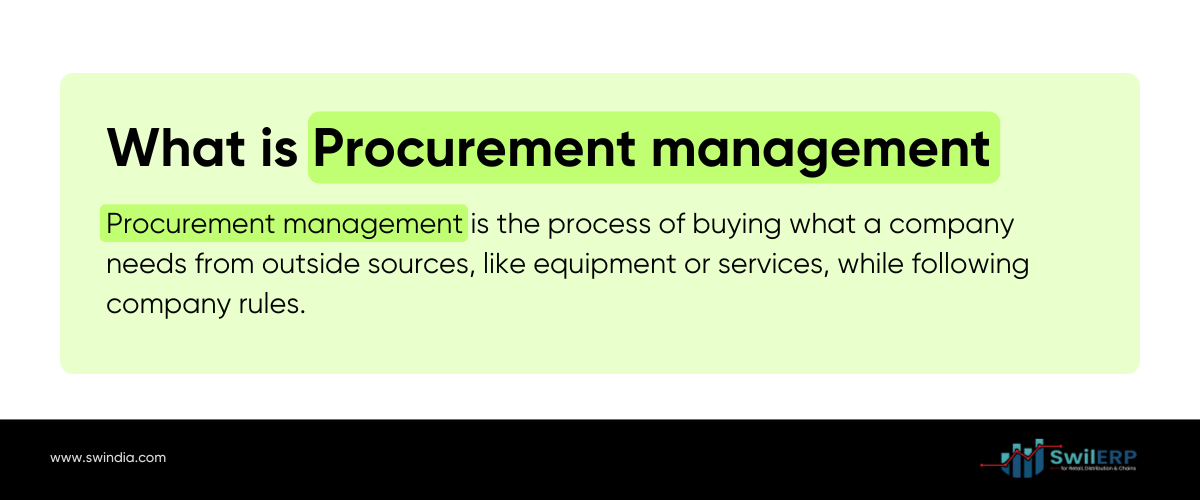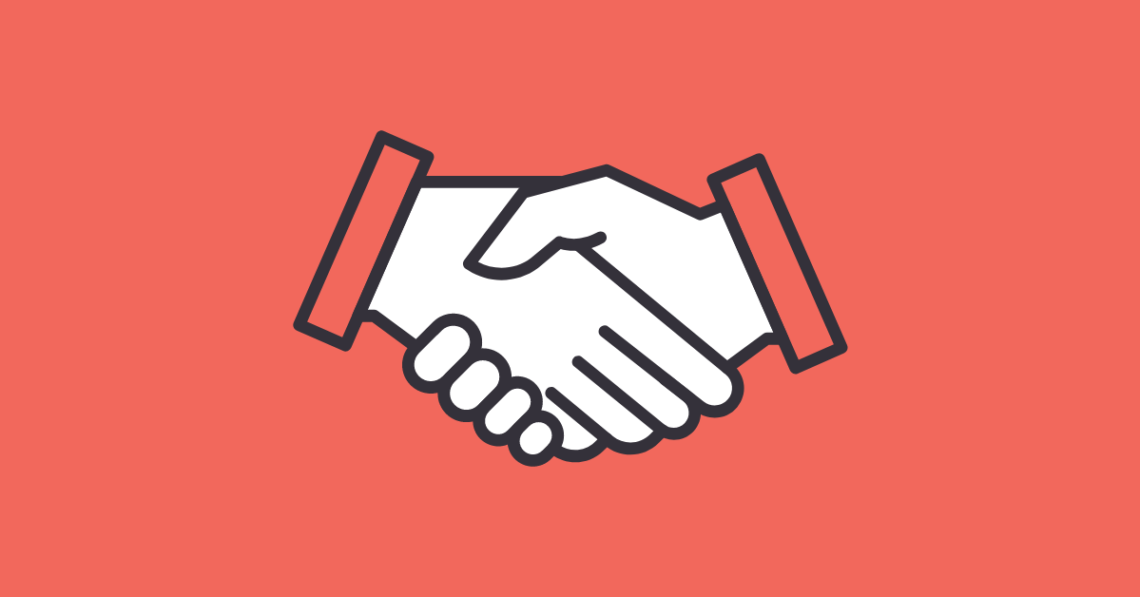What is procurement management? 
Procurement management revolves around getting goods and services from outside sources. It kicks off by recognizing the requirement for a product or service. Then, it’s about tracking down appropriate suppliers, hammering out terms and conditions, placing orders, and making sure stuff shows up on time. All this needs to happen while sticking to the company’s policies and regulations. It’s a whole process. In simpler terms, procurement management is all about getting the goods and services a company needs from outside sources. This can include anything from workplace equipment to raw materials for production to expert consultancy services.
Why is procurement management important?
Effective procurement management is crucial for businesses because it directly impacts their bottom line, quality of products and services, and overall competitiveness. By managing procurement processes effectively, organizations can achieve cost savings, ensure consistent quality, mitigate risks, and foster strong supplier relationships.
The art of procuring goods and services in a way that minimizes risks, produces high-quality products, and saves money is known as effective procurement management. This can be done by carefully choosing suppliers, negotiating good prices, and making sure everything is delivered on time and according to specifications. Businesses can reduce expenses, raise the caliber of their products, and beat out the competition by implementing these strategies.
What are the steps of the procurement process?
The procurement process typically involves the following steps:

Identifying and planning
This initial step involves recognizing the need for a product or service and determining the specifications, quantities, and delivery requirements. Planning makes it more likely that the procurement procedure will go well and support the overall goals of the company.
Choosing and selecting suppliers
Once the requirements are defined, the next step is to identify potential suppliers. This entails looking into and assessing suppliers according to criteria including cost, reputation, quality, and delivery capabilities.
Negotiating the contract
After selecting a suitable supplier, negotiations take place to finalize the terms and conditions of the contract. This includes aspects such as pricing, delivery schedules, payment terms, and any additional services or warranties.
Placing the purchase order
Once the contract is finalized, a purchase order is issued to the supplier, specifying the details of the required goods or services, quantities, and delivery instructions.
Accelerating the order
During this phase, the procurement team monitors the order progress and communicates with the supplier to ensure timely delivery and address any potential issues or delays.
Receipt and inspection of purchase
Upon receiving the goods or services, they are inspected to verify that they meet the specified requirements and comply with the contract terms.
Clearing the invoice and payment
After the goods or services have been received and accepted, the supplier’s invoice is processed, and payment is made according to the agreed-upon terms.
Maintaining relationships and records
Procurement management also involves maintaining ongoing relationships with suppliers, monitoring their performance, and keeping accurate records of all procurement activities for future reference and auditing purposes.
Benefits of Procurement Management
Effective procurement management offers several benefits to organizations, including:

Increased certainty and quality
By establishing clear specifications and selecting reliable suppliers, organizations can ensure that they receive high-quality goods and services that meet their requirements.
Cost control
Proper procurement management enables organizations to negotiate favorable terms, leverage economies of scale, and achieve cost savings through strategic sourcing and supplier management.
Reduced risk
Thorough evaluation of suppliers, contract negotiation, and ongoing monitoring help mitigate risks associated with supply chain disruptions, quality issues, and legal or regulatory compliance problems.
How does procurement management work?
Procurement management typically involves a dedicated team or department responsible for overseeing the entire procurement process. This team works closely with various stakeholders within the organization, such as department heads, finance, and legal teams, to ensure that procurement activities align with organizational goals and comply with relevant policies and regulations.
Key responsibilities of the procurement team
The procurement team plays a crucial role in ensuring the efficient and effective acquisition of goods and services. Their key responsibilities include:

Supplier identification
Researching and evaluating potential suppliers based on criteria such as product quality, pricing, delivery capabilities, and reliability.
Order tracking
Monitoring the progress of orders from placement to delivery, communicating with suppliers, and addressing any issues or delays.
Supplier diversification
Maintaining a diverse pool of suppliers to mitigate risks associated with overreliance on a single vendor and to foster competition.
Contract management
Negotiating and managing contracts with suppliers, ensuring compliance with terms and conditions, and addressing any contractual disputes or issues.
Vendor relationship management
Building and maintaining strong relationships with suppliers through regular communication, performance evaluations, and collaboration.
Approved vendor list development
Establishing and maintaining a list of approved suppliers that have been thoroughly vetted and meet the organization’s requirements for quality, reliability, and compliance.
Obligation fulfillment
Ensuring that the organization fulfills its contractual obligations to suppliers, such as timely payments and adherence to agreed-upon terms and conditions.
Functions of Procurement Management
The procurement management function encompasses various activities and processes, including:
Vendor management
Vendor management is the process a business uses to find reliable suppliers for the goods and services it needs. This involves searching for potential vendors, assessing their qualifications, and choosing the best fit. But it doesn’t stop there! It’s also about maintaining positive relationships with chosen vendors and monitoring their performance to ensure they continue to meet your needs.
Identifying, evaluating, and selecting suitable vendors, as well as managing ongoing vendor relationships and performance.
Purchasing strategy enforcement
Purchasing strategy enforcement involves creating clear guidelines for how your organization buys things. These guidelines consider your overall goals, like saving money or finding reliable suppliers, to ensure every purchase aligns with your company’s best interests.
Developing and implementing procurement policies and strategies that align with the organization’s goals and objectives.
Purchase requisition
Processing and approving requests for goods and services from various departments within the organization.
The purchase requisition is like a shopping list for a company. Different departments submit requests for things they need, like office supplies, equipment, or services from outside vendors. This helps ensure everyone gets what they need while keeping track of spending.
Purchase order (PO) management
Purchase order (PO) management is the process of creating and overseeing purchase orders. This ensures all the details on the order are correct, following both company guidelines and any agreements with suppliers. In simpler terms, it’s like keeping track of your shopping list to make sure you get the right things and follow any deals you make with the store.
Generating and managing purchase orders, ensuring accurate information, and compliance with organizational policies and supplier agreements.
Invoice approval and payment processing
Invoice approval and payment processing is the process of carefully checking invoices from suppliers to make sure they are correct and follow the agreed-upon terms of a contract. This includes verifying things like the items or services provided, the prices charged, and any discounts offered. Once everything is confirmed to be accurate, the process ensures the supplier is paid promptly. This helps maintain good relationships with vendors and keeps your company’s finances in order.
Verifying and approving supplier invoices, ensuring accuracy and adherence to contractual terms, and facilitating timely payments.
Vendor and contract management
Vendor and contract management ensures everything runs smoothly between your company and its suppliers. This involves creating clear agreements, overseeing performance, and resolving any disagreements that may arise.
Negotiating and managing contracts with suppliers, monitoring compliance, and addressing any contractual issues or disputes.
Contract administration
Contract administration is the careful record-keeping of all purchasing actions, agreements with suppliers, and vendor details. This ensures everything is documented properly for future reviews and to make sure all regulations are followed.
Maintaining accurate records of all procurement activities, contracts, and supplier information for auditing and compliance purposes.
How to improve existing procurement management?
To enhance the efficiency and effectiveness of procurement management, organizations can consider implementing the following strategies:
Approvals
Streamline approval processes by establishing clear approval workflows and leveraging technology to automate approvals, reducing delays and bottlenecks.
Invoice matching
Implement a robust invoice matching process to ensure that invoices align with purchase orders, contracts, and goods or services received, minimizing errors and overpayments.
Notifications
Implement a notification system to alert relevant stakeholders about important events, such as approaching contract renewals, delivery delays, or supplier performance issues.
Integration
Integrate procurement management systems with other organizational systems, such as enterprise resource planning (ERP) and financial systems, to improve data accuracy, visibility, and reporting capabilities.
Data storage
Implement secure and centralized data storage solutions to maintain accurate and accessible records of procurement activities, contracts, and supplier information.
Why should you automate procurement management?
Automating procurement management processes can provide numerous benefits, including:
Increased productivity
Automation can reduce the time and effort required for manual tasks, such as data entry, approval routing, and document management, allowing procurement teams to focus on more strategic activities.
Eliminating manual errors
By automating processes and reducing manual interventions, the risk of human errors, such as data entry mistakes or missed deadlines, is minimized.
Visibility into spend
Automated procurement management systems provide real-time visibility into organizational spending, enabling better budget control and informed decision-making.
Centralized repository
Automated systems offer a centralized repository for storing and accessing procurement-related data, contracts, and supplier information, improving accessibility and collaboration.
Improved collaboration
Automated workflows and centralized data storage enable better collaboration among procurement teams, stakeholders, and suppliers, enhancing communication and decision-making processes.
Removal of approval bottlenecks
Automated approval workflows and notifications can help identify and address approval bottlenecks, ensuring that procurement processes move forward efficiently.
How can SwilERP help in procurement management?
SwilERP is an enterprise resource planning (ERP) solution that offers comprehensive procurement management capabilities. Here’s how SwilERP can assist in streamlining procurement processes:
Centralized procurement
SwilERP provides a centralized platform for managing the entire procurement lifecycle, from requisition to payment, enabling greater visibility and control.
Supplier management
The solution allows organizations to maintain a comprehensive database of suppliers, track their performance, and manage vendor relationships effectively.
Standard policies
SwilERP enables organizations to define and enforce standard procurement policies, ensuring consistency and compliance across the organization.
Advanced planning
SwilERP offers advanced planning capabilities, such as demand forecasting and inventory optimization, to support proactive procurement decisions and minimize stock-outs or overstocking.
Automation
SwilERP automates various procurement processes, including purchase order generation, invoice matching, and approval workflows, reducing manual effort and increasing efficiency.
Digitized purchase system
The solution provides a digitized purchase system, enabling electronic submission and approval of purchase requisitions, streamlining the procurement process.
Grow your business with an omnichannel ERP
In addition to its robust procurement management capabilities, SwilERP is an omnichannel ERP solution designed to support and streamline various business processes across multiple channels. SwilERP hooks up procurement with other major players like inventory tracking, finance, and customer relationship management. This tag-team approach helps businesses amp up their operations game, make smarter calls, and ultimately, drive growth.
With SwilERP’s procurement tricks up its sleeve, organizations can score some serious wins. We’re talking cost-cutting through strategic sourcing, tighter supplier bonds, rule-following on lock, and a crystal-clear view of where the cash is flowing.
By automating manual processes and providing a centralized platform for managing procurement activities, SwilERP enables organizations to focus on strategic initiatives, drive innovation, and maintain a competitive edge in their respective industries.
Whether a small business or a large enterprise, SwilERP’s scalable and customizable solutions can adapt to the unique requirements of any organization, offering a comprehensive and integrated approach to procurement management and overall business operations.
By embracing SwilERP’s procurement management solutions, businesses can confidently navigate the complexities of procurement, foster strong supplier relationships, and achieve greater operational excellence, ultimately driving growth and success in an ever-evolving business landscape.








